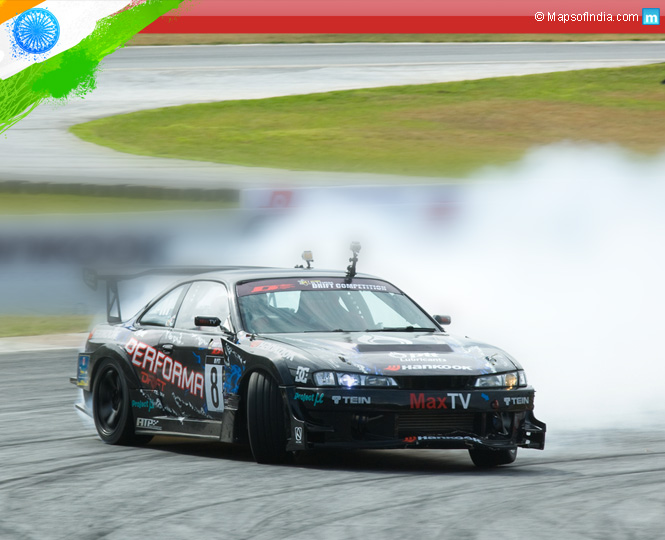
If you’ve ever managed to swing out your car’s rear end on a wet road, or even on dirt or anywhere for that matter – due to the loss of traction and you and the car have struggled for several feet to regain control, with the steering pointing opposite to the direction of the turn and in that of your displacement, you’ve drifted.
Drifting is but going sideways in the truest sense, but with total control of your entry and exit to and from a bend, curve or sharp turn. A car “drifts” when the rear slip angle is greater than the front slip angle such that the front wheels are, in relation to the direction of the turn, in opposite lock or for those who are familiar with the term “counter steering”. It has been, since long, a technique where the driver would intentionally oversteer, allowing the rear wheels or all fours, to lose traction, at the same time maintaining control from the entry and exit of any corner.
In modern times, with tyres having the ability to hold on to a vertical wall, drifting is an art and for some, an enviable skill in motorsports. The last few decades have seen drift racing become a motorsport all on its own.
Born on the twisties and turnies of Japan’s winding mountain roads sometime around the nineties, Drifting, both as a sport and driving style, has spread across the world both in a level of respect as a sport and popularity amongst enthusiasts and followers alike.
Apart from the fact that they can be crash-and-dead level dangerous, mountain roads provide for some of the most ideal drift tracks in the world. Countless tight “C” and “S” shaped turns help drivers to learn, improve on and master some of the most advanced drifting skills.
Among the founding fathers of drifting techniques was motorcycle legend turned race driver – Kunimitsu Takahashi and his ardent fan, Keiichi Tsuchiya – who later went on to take the title of Dorikin or Drift King. Tsuchiya was a keen follower of Takahashi’s drift techniques and would practice his skills on the mountain roads of Japan. He quickly built a reputation for himself among the racing crowd and in 1987, several magazines and tuning garages even produced a video of his drifting skills. Along with the chief editor of Option Magazine, Tsuchiya became one of the founding fathers of one of the first exclusive drift events – the D1 Grand Prix.
Drifting events are judged on parameters like the drift line, angle of drift, speed and show factor – the line involves taking the correct or most accurate path for the drift, the angle is of the car and the wheels giving direction to the drift, and the showfactor is the amount of smoke from the burning rubber, how close the driver comes to the walls or the designated clipping points and the crowds reaction to the whole thing. Speed is the summation of the entry speed, the speed through the turn and the exit speed – all of them, the faster the better. Judging takes place on a small segment of the circuit with good visibility, and opportunities for drifting. A typical Drift race has two sessions – a qualifying/practice round, and a final session. In the former, the drifters get individual passes in front of judges who narrow competitors down to a final 16.
In order to drift, one requires a car with the engine power being transmitted to the rear wheels. A drift car is preferred to come fitted with a limited slip differential or a welded one. That is the most basic criteria to be able to drift. A manual gearbox, working handbrake, coilover suspension and a supportive seat provide for a decent introduction to drifting. However, there are always bigger and better upgrades to go more professional and improve skilles with steering geometry changes, to increase steering lock, strong and high endurance clutch systems and elevated engine power. A little bit of the power can be compensated with increased pressure in the rear tyres. The use of poor quality and gripless tyres are no longer needed to provide for loss of traction. Since the professional drift cars need lateral grip to attain great speeds and wide angles, they run on cut slick track tyres. The gripless tyres are however still employed and deemed good enough to learn throttle control.
December 2012 saw India’s first and only professional Drift spec car introduced in front of a huge crowd of enthusiasts by our country’s first drift champion – Gautam Singhania, Chairman of Raymond group and also the founder of the Supercars club of India. Singhania had the car custom built for this display and launch, post his victory at the All stars Drift European series in the amateur racer’s category.
So, if you’re in for some sideways action, get yourself a car that’s high on torque, that comes out on the rear wheels, is sports bad with bald tyres and get on an unused /empty road or a dirt patch. Also, it would be great if you could throw in some experienced company of fellow drivers or co-passengers and responsibility seasoned with great precaution.



